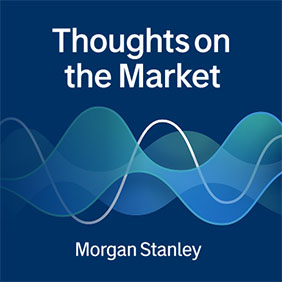Bracing for Sticker Shock
July 12, 2025
As U.S. retailers manage the impacts of increased tariffs, they have taken a number of approaches to avoid raising prices for customers. Our Head of Corporate Strategy Andrew Sheets and our Head of U.S. Consumer Retail and Credit Research Jenna Giannelli discuss whether they can continue to do so.

-
 Andrew Sheets
Andrew Sheets
Thoughts on the Market
Listen to our financial podcast, featuring perspectives from leaders within Morgan Stanley and their perspectives on the forces shaping markets today.

Up Next
The Future Reckoning of Tariff Escalation
Transcript
Welcome to Thoughts on the Market. I’m Michael Zezas, Global Head of Fixed Income Research and Public Policy Strategy. Today: The latest on U.S. tariffs and their market impact.
It’s Thursday, July 10th at 12:30pm in New York.
It's been a newsy week for U.S. trade policy, with tariff increases announced across many nations. Here’s what we think investors need to know.
First, we think the U.S. is in a period of tactical escalation for tariff policy; where tariffs rise as the U.S. explores its negotiating space, but levels remain in a range below what many investors feared earlier this year. We started this week expecting a slight increase in U.S. tariffs—nothing too dramatic, maybe from 13 percent to around 15 percent driven by hikes in places like Vietnam and Japan. But what we got was a bit more substantial.
The U.S. announced several tariff hikes, set to take effect later, allowing time for negotiations. If these new measures go through, tariffs could reach 15 to 20 percent, significantly higher than at the beginning of the year, though far below the 25 to 30 percent levels that appeared possible back in April. It’s a good reminder that U.S. trade policy remains a moving target because the U.S. administration is still focused on reducing goods trade deficits and may not yet perceive there to be substantial political and economic risk of tariff escalation. Per our economists’ recent work on the lagged effects of tariffs, this reckoning could be months away.
Second, the implications of this tactical escalation are consistent with our current crossasset views. The higher tariffs announced on a variety of geographies, and products like copper, put further pressure on the U.S. growth story, even if they don’t tip the U.S. into recession, per the work done by our economists. That growth pressure is consistent with our views that both government and corporate bond yields will move lower, driving solid returns. It's also insufficient pressure to get in the way of an equity market rally, in the view of our U.S. equity strategy team. The fiscal package that just passed Congress might not be a major boon to the economy overall, but it does help margins for large cap companies, who by the way are more exposed to tariffs through China, Canada, Mexico, and the EU – rather than the countries on whom tariff increases were announced this week
Finally, How could we be wrong? Well, pay attention to negotiations with those geographies we just mentioned: Mexico, Canada, Europe, and China. These are much bigger trading partners not just for U.S. companies, but the U.S. overall. So meaningful escalation here can drive both top line and bottom line effects that could challenge equities and credit. In our view, tariffs with these partners are likely to land near current levels, but the path to get there could be volatile.
For the U.S., Mexico and Canada, background reporting suggests there’s mutual interest in maintaining a low tariff bloc, including exceptions for the product-specific tariffs that the U.S. is imposing. But there are sticking points around harmonizing trade policy. The dynamic is similar with China. Tariffs are already steep—among the highest anywhere. While a recent narrow deal—around semiconductors for rare earths—led to a temporary reduction from triple-digit levels, the two sides remain far apart on fundamental issues.
So when it comes to negotiations with the U.S.’ biggest trading partners, there’s sticking points. And where there’s sticking points there’s potential for escalation that we’ll need to be vigilant in monitoring.
Thanks for listening. If you enjoy Thoughts on the Market please leave us a review. And tell your friends about the podcast. We want everyone to listen.

Are Foreign Investors Fleeing U.S. Assets?
Transcript
Welcome to Thoughts on the Market. I’m Serena Tang, Morgan Stanley’s Chief Cross-Asset Strategist. Today – is the demand for U.S. assets declining? Let's look at the recent trends in global investment flows.
It’s Wednesday, July 9th at 1pm in New York.
The U.S. equity market has reached an all-time high, but at the same time lingering uncertainty about U.S. trade and tariff policies is forcing global investors to consider the riskiness of U.S. assets. And so the big question we need to ask is: are investors – particularly foreign investors – fleeing U.S. assets?
This question comes from recent data around fund flows to global equities. And we have to acknowledge that demand for U.S. stocks overall has declined, going by high-frequency data. But at the same time, we think this idea is exaggerated.
So why is that? As many listeners know, fund flows – which represent the net movement of money into and out of various investment vehicles like mutual funds and ETFs – are an important gauge of investor sentiment and market trends. So what are fund flows really telling us about investors’ sentiment towards U.S. equities? It would be nice to get an unequivocal answer, but of course, the devil is always in the details. And the problem is that different data sources and frequencies across different market segments don’t always lead to the same conclusions.
Weekly data across global equity ETF and mutual funds from Lipper show that international investors were net buyers through most of April and May. But the pace of buying has slowed year-to-date versus 2024. Still, it remains much higher than during the same period in 2021 through 2023. Treasury TIC data point to something similar – a slowdown in foreign demand, but not significant net selling.
So where are the flows going, if not to the U.S.? They are going to the rest of the world, but more particularly, Europe. Europe stocks, in fact, have been the biggest beneficiary of decreasing flows to the U.S. Nearly $37 billion U.S. has gone into Europe-focused equity funds year-to-date. This is significantly higher than the run-rates over the prior five years. What’s more notable here is that year-to-date, flows to European-focused ETFs and mutual funds dominated those targeting Japan and Emerging Markets. This suggests that Europe is now the premier destination for equity fund flows, with very little demand spillovers to other regions' equity markets.
These shifts have yet to show up in the allocation data, which tracks how global asset managers invest in stocks regionally. Global equity funds' portfolio weights to Rest-of-the-World has gone up by roughly the same amount as allocation to the U.S. has come down. But allocation to the U.S. has actually gone down by roughly the same amount, as its share in global equity indices; which means that If allocation to the U.S. has changed, it's simply because the U.S. is now a smaller part of equity indices.
Meanwhile, an estimated U.S.$9 billion from Rest-of-the World went into international equity funds, which excludes U.S. stocks altogether. Granted, it’s not a lot; but scaled for fund assets, it's the highest net flows international equities have seen. In other words, some investors are choosing to invest in equities excluding U.S. altogether.
These trends are unlikely to reverse as long as lingering policy uncertainty dampens demand for U.S.-based assets. But as we've argued in our mid-year outlook, there are very few alternative markets to the U.S. dollar markets right now. U.S. stocks might start to see less marginal flows from foreign investors – to the benefit of Rest-of-the-World equities, especially Europe. But demand is unlikely to dry up completely over the next 12 months.
Thanks for listening. If you enjoy the show, please leave us a review wherever you listen and share Thoughts on the Market with a friend or colleague today.

Sign up to get Morgan Stanley’s Five Ideas newsletter delivered weekly to your inbox.
Subscribed!
Thank you for subscribing to our blog newsletter. Stay tuned to hear about Morgan Stanley ideas!




